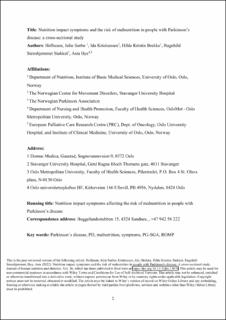Nutrition impact symptoms and the risk of malnutrition in people with Parkinson's disease: A cross-sectional study
Helliesen, Julie Sørbø; Kristiansen, Ida; Brekke, Hilde Kristin; Støkket, Ragnhild Stenshjemmet; Bye, Asta
Peer reviewed, Journal article
Accepted version
Permanent lenke
https://hdl.handle.net/11250/3062919Utgivelsesdato
2022Metadata
Vis full innførselSamlinger
Originalversjon
Journal of human nutrition and dietetics. 2022, 36 (1), 40-50. http://dx.doi.org/10.1111/jhn.13070Sammendrag
Background: People with Parkinson’s disease (PD) often experience symptoms that affect their ability to eat. This may contribute to weight loss and increased risk of malnutrition. Objective: Our aim was to quantify the extent of nutrition impact symptoms (NIS) in the population and a scoring system of NIS is incorporated in the tool used to identify malnutrition. Methods: In this cross-sectional study members of the Norwegian Parkinson's Association, with any PD diagnosis and stage of illness, were invited to respond to an online 24-item
questionnaire. Questions from two validated questionnaires, abridged patient-generated subjective global assessment (aPG-SGA) and Radboud Oral Motor Inventory for Parkinson’s disease (ROMP), were adapted to an online format.
Results: The questionnaire was sent to 3047 members, of which 508 persons (17%) responded (61% men). In total, 59% were categorized as well-nourished, 34% at risk of malnutrition and 6.5% as malnourished. A quarter of all participants reported symptoms that affected food intake. The most frequent symptoms were constipation (14.2%) and dry mouth (13.4%). On average (SD), malnourished participants reported 3.4 (1.4) symptoms as opposed to 0.1 (0.3) per well-nourished participant. Malnourished participants had more swallowing problems than well-nourished, a mean total ROMP score of 15.5 (6.0) versus 9.0 (2.9) (p <0.001). As the number of points in the ROMP-score increased by one, the points in the aPG-SGA score increased with 37% (95% CI 0.309-0.428). Conclusion: Risk of malnutrition was largely related to NIS, especially dysphagia in people with PD. Symptoms affecting food intake should be systematically mapped and treated in conjunction with PD to prevent malnutrition.
